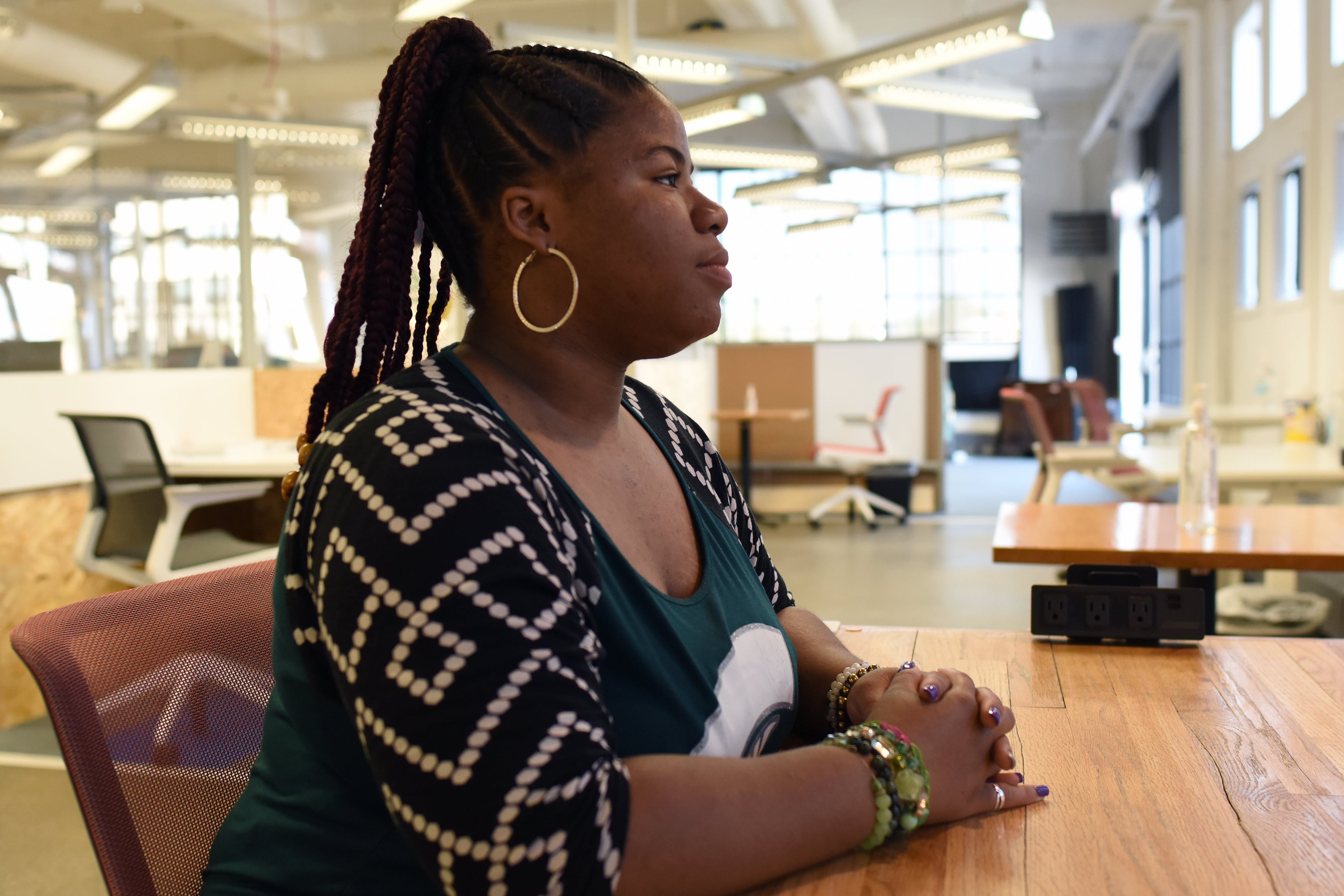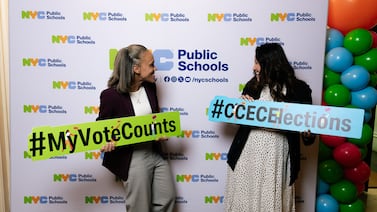Sign up for Chalkbeat Detroit’s free daily newsletter to keep up with the city’s public school system and Michigan education policy.
It was College Decision Day at Martin Luther King Jr. Senior High School, and Perriel Pace was walking through the halls wearing a sparkly shirt with a Michigan State emblem.
Pace had been excited to find the shirt at a church rummage sale. But on that day, it was a “bittersweet” choice of attire.
The Detroit high school senior was accepted to MSU months ago. She wants to become the first person in her family to go to college. But that hinges on federal financial aid. And with just a few months before the college semester begins, she still doesn’t have an answer about that funding.
Pace is among many students in limbo across the country due to the rocky rollout of a new version of the Free Application for Federal Student Aid, or FAFSA. The process this year has been mired in confusion — the revamped form was released at the end of last year and has come with no shortage of technical issues. Some students are still shut out of the system. Others, like Pace, managed to fill out and submit the form — but still, they wait.
In Detroit, these problems have tested the resilience of vulnerable young people already facing barriers to higher education. It is a roadblock that looms large in a city where just 17% of residents hold a college degree.
Pace has had issues finding stable housing and receives support under the federal McKinney-Vento Homeless Assistance Act. She lives with her cousin now. Last year she stayed in a shelter. Despite those challenges, she is highly engaged academically and civically. Pace has participated in student government, performed in school plays, and is involved in a number of youth organizations across the city that advocate for social justice.
She wants to convert that advocacy into a career and either become a lawyer for incarcerated people, or get her doctorate in education and sit on the Michigan State Board of Education.
She feels a sense of responsibility to carve a path into higher education — if she can get the money to go.
“Everybody, all my family, is looking to me. No one ever got the opportunity. And that’s what held them back as well — funding,” Pace said.
Students seeking college aid should ‘not despair’
The situation has had a clear impact on the state’s students who are planning to go to college.
According to recent data, 38% of high school seniors in Michigan have completed the FAFSA, a 21% decrease compared to this time last year.
These delays also have many schools on edge and have led them to rework their own timelines. The Michigan Association of State Universities’ Mia Murphy said that many public universities have moved back enrollment and deposit deadlines to accommodate students and their families.
“We want students and their families to know that they’ve done nothing wrong, that this is unprecedented, and it should never be like this again,” Murphy wrote in an email to Chalkbeat.
At Wayne State University, school staff has been working “around the clock” to help students with lingering FAFSA stress, said Ahmad Ezzedine, vice president for academic student affairs and global engagement.
Last year, 54% of the university’s incoming freshman class attended tuition-free thanks to a university program that utilizes a mix of state and federal aid, Wayne State scholarships, and grants to help students from low-income households attend.
“So we are confident that students will have very generous offers if their tuition is not fully covered based on their family situation,” Ezzedine said.
His message to students mirrored what admissions officers at local institutions of higher education like Michigan State and the University of Michigan-Dearborn told Chalkbeat: “What we want is that students don’t despair and don’t let something like this stop them.”
Still, for many vulnerable students, getting the necessary college aid is just one piece of their higher education puzzle.
College roadblocks persist, but so do Detroit students
The FAFSA rigmarole this year is particularly hard on Detroit students who face additional barriers to college, like finances, family responsibilities, and a lack of transportation, said Stacey Brockman, a Wayne State professor of educational leadership and policy who studies the pathways to college for Detroit students.
The latter is especially pronounced in a city ruled by automobiles and lacking robust public transportation.
In a forthcoming study looking at transit barriers and costs that students attending Detroit area institutions face, Brockman found that students using public transit to commute to community colleges spent upwards of an hour getting to class.
“Just objectively, that’s a really long commute,” she said.
More than half of students Brockman surveyed who had stopped going to college said finding reliable transportation was a top reason. Another 40% said they struggled to pay for it.
For some students, that problem begins well before they are thinking about college. In a recent survey, parents with children attending Detroit schools reported frequent challenges in accessing a vehicle.
Brockman’s work also highlights that many students don’t give up.
She found that one in five community college students in the Detroit area were still enrolled and making progress towards a degree in their fifth year. Many are working and supporting themselves. Slowly and steadily, they make it through.
Something similar could be said about the level of perseverance necessary to complete the FAFSA this year.
Trying to create a college-going culture
Katey, a senior at Detroit Cristo Rey High School, started filling out the FAFSA form back in January, a few weeks after it became available. (Chalkbeat is only using her first name because of her family’s immigration status.)
She’s on track to be a first-generation college student. Her parents are from Guadalajara, Mexico, and her household is of mixed immigration status. The federal government’s changes to this year’s FAFSA precluded her from completing the form. The revamped iteration asks for a parent’s Social Security number, something her parents do not have.
So Katey filled out a different form to confirm her father’s identity. The system rejected that form too, “but I never gave up,” she said.
Katey attended a FAFSA event through her school where she met Tanya Aho of Urban Neighborhood Initiatives, one of several community organizations helping people carve a path to college.
For months, Aho and Katey met and tinkered with the form and experimented with different strategies. Ultimately they figured out a workaround. Students around the country faced similar issues.
Aho said the glitch Katey experienced affected many students from backgrounds like hers up until the spring. Meanwhile, getting help in Spanish from FAFSA staff has been nearly impossible.
These layers of red tape are sending a message to students, she said.
“My kids are like, ‘You know, it doesn’t feel like they want us to get this money.’ And I really can’t argue … it doesn’t feel like this population has been a priority,” Aho said.
Katey spent difficult hours researching how to even apply for college. But it was the only way to get closer to her childhood dream of becoming a veterinarian. In the fall, Katey will attend Michigan State. It was her pick given the school’s veterinary program.
At Western International High School in Southwest Detroit, where nearly three quarters of students are Hispanic or Latino, there are two bilingual college transition advisers for 400 seniors, Alicia Alvarez and Gina Dossantos. That’s nowhere near enough, Alvarez said.
Many college advisers were eliminated from several Detroit schools last year after the district made budget cuts, including at Martin Luther King Jr. Senior High School, which Perriel Pace attends. At Western, Alvarez turned down a buyout last year but the school was ultimately able to retain her given its high enrollment numbers — more than 1,900 students attend the high school. Dossantos, meanwhile, works at the school through a partnership with the University of Michigan.
Many of the students Alvarez and Dossantos help come from vulnerable households. And they estimate roughly 20% of the students they have been working with are newcomers, often from Central American countries where they and their families escaped violence and death.
“They have to leave everything and come to this country — and then we can’t even help them get into college,” Alvarez said.
The FAFSA debacle has hampered the two advisers’ efforts to nurture a college-going culture at Western, and students are getting discouraged. “They are just like, you know what, maybe this isn’t for me,” Alvarez said.
Still, there are signs these advisers are making a dent. Alvarez is a graduate of Western herself. During her time at the school, there was much less emphasis on going to college, and there were no College Decision Day celebrations. But the contrast between then and now became clearer to her this year, when a Western student got into Harvard.
“It’s nice to see that the school is making progress in that way and to be part of that change” she said. “That feels really good.”
Robyn Vincent is a reporter for Chalkbeat Detroit, covering Detroit schools and Michigan education policy. You can reach her at rvincent@chalkbeat.org.







